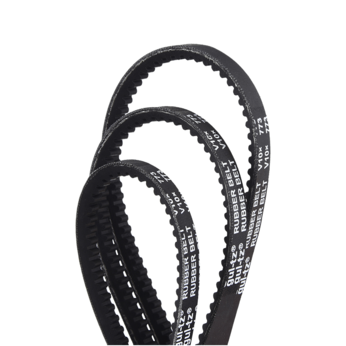What are the advantages of synchronous timing belts' tooth design
The tooth design of the synchronous toothed belt is a key factor in achieving high-precision, high-efficiency and high-reliability transmission. The belt meshes with the tooth grooves on the synchronous wheel through the teeth arranged along the length of its surface, thereby realizing non-slip mechanical synchronous transmission. Compared with traditional flat belts or V-belts, the tooth design of the synchronous toothed belt significantly improves the transmission efficiency and performs well in terms of dynamic response, load capacity and service life. The tooth profile of the synchronous toothed belt is mainly divided into three categories: trapezoidal teeth, arc teeth and modified teeth. These structures are optimized to meet the needs of diverse industrial applications.
Trapezoidal teeth are the earliest design used in synchronous toothed belts. They are characterized by straight lines on both sides of the teeth and a flat top. This design is simple and easy to process, has a certain rigidity when meshing, and is suitable for ordinary mechanical transmission systems. Although the transmission efficiency of trapezoidal teeth is slightly insufficient compared to arc teeth under high load or high-speed operation conditions, due to its low processing cost and mature manufacturing process, it performs stably and reliably in medium and low speed and medium load applications. In contrast, as an improved version of trapezoidal teeth, circular arc teeth adopt a circular arc-shaped tooth side design, which increases the contact area between teeth and gears, ensures smoother meshing, reduces local contact stress and wear, and thus prolongs the service life of the belt body and synchronous wheel. The high meshing accuracy and load resistance of circular arc teeth make them particularly suitable for equipment that requires high torque output and high-speed transmission, such as automotive engine timing systems, automated robots, and large industrial conveying systems. Modified teeth are further optimized on the basis of circular arc teeth. Their tooth profile design takes into account the motion error and deformation compensation during gear meshing, so that the toothed belt is more evenly stressed during meshing, thereby reducing operating noise, improving dynamic stability and transmission efficiency, and is particularly suitable for precision equipment and applications with high requirements for quietness.
Another significant advantage of the tooth design is its positive contact transmission method. Traditional friction belts rely on the friction between the belt and the wheel groove to transmit power during the transmission process. This method is prone to slippage, which causes transmission errors and system instability. The synchronous toothed belt, through the geometric meshing between teeth, ensures that the belt body can accurately drive the synchronous wheel to rotate the corresponding angle every time it rotates, thus realizing true synchronous transmission. This positive meshing not only improves the reliability of the transmission system, but also makes the system respond more quickly and accurately, which is suitable for industrial applications with complex working conditions and frequent starts and stops.
The influence of tooth design on transmission efficiency is also significant. Due to the precise matching between the tooth shape and the gear groove, the energy loss of the synchronous toothed belt is extremely low, and the transmission efficiency can be as high as more than 98%, far exceeding the general friction transmission method. This high-efficiency transmission not only helps to reduce system energy consumption, but also reduces the overall size of the equipment and realizes a compact structure. In addition, the high meshing rate means that the belt body per unit width can withstand a larger load, reducing the dependence on the pulley size, and further improving the flexibility and adaptability of the transmission system.
Hot Products
-
 View More
View More
-
 View More
View More
V-belt For Industry
-
 View More
View More
T Type Industry Rubber Synchronous Belt
-
 View More
View More
Toothed wedge belt
-
 View More
View More
Thickened timing belt
-
 View More
View More
Open Timing Belt
-
 View More
View More
Automotive V-belt
-
 View More
View More
Rubber Flat Belt
-
 View More
View More
Ribbed Belt
-
 View More
View More
Synchronous Pulley
-
 View More
View More
Arc tooth industrial rubber synchronous belt
-
 View More
View More
Automotive timing belt

 English
English 简体中文
简体中文
